Mongolian Beef is a delicious beef stir fry recipe served with lots of onions and a tasty sauce. This flavorful dish is popular in Chinese restaurants, and also actually very easy to make at home - here's my Mongolian Beef Stir Fry recipe!
What is Mongolian Beef?
Mongolian beef 蒙古烤肉 is a dish that consists of stir fried beef with onions. Sometimes it's served with other vegetables, and is not too spicy. Normally served with rice or fried rice or sometimes noodles.
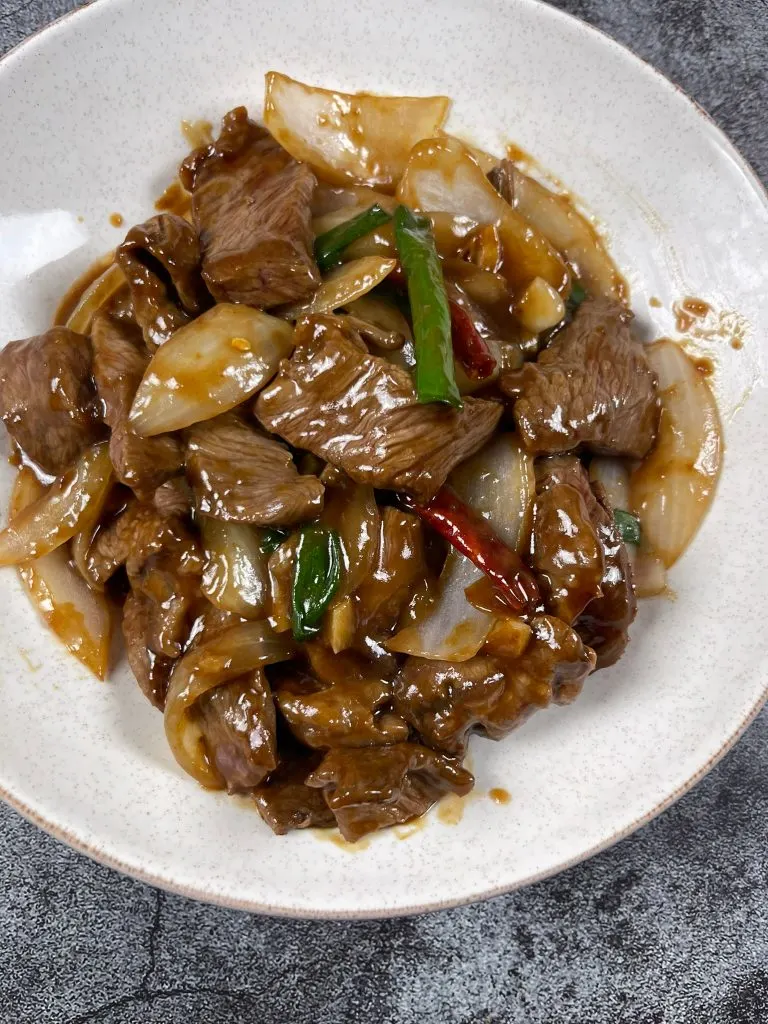
Origin of Mongolian Beef
Contrary to popular belief, Mongolian Beef is actually NOT from Mongolia! This tasty dish actually originates from Taiwan!
Mongolian beef 蒙古烤肉 is one of the meat dishes created in Taiwan by a famous Taiwanese comedian and restaurateur Wu Zhaonan. He moved from Beijing to Taiwan during the Chinese Civil War, and actually was going to call it "Beijing BBQ" but didn't due to… well, politics. Anyway, this would actually explain why none of the ingredients or the preparation is like traditional Mongolian cuisine.
What kind of beef to use?
Ultimately the type of steak to use is up to you - you can pick your favorite cut of beef. However, I normally use flank steak, or sirloin steak (pictured below).
Just make sure to cut evenly in to strips or slices so that it cooks evenly!
What goes with Mongolian beef?
Mongolian beef goes super well served with rice! You can also serve it with some fried rice, or noodles.
Since Mongolian Beef has less veggies than some other more veggie forward dishes, and it's so flavorful, I recommend some simple veggie side dishes:
Stir Fry Asparagus with Garlic
Shanghai Bok Choy Stir Fry with Garlic
By the way, if you’re interested in other dishes I like to order for Chinese takeout that I also make at home, here they are!
- Chicken with Broccoli
- Moo Goo Gai Pan
- Broccoli Beef
- Chicken Fried Rice
- Shrimp Fried Rice
- Twice Cooked Pork
- Snow Peas Beef Stir Fry
- Chinese Wontons
- Chinese Dumplings
Wow! This might be the first time I’ve noticed how many I love making at home!
Is Mongolian beef keto friendly?
If you're ordering from a restaurant, it is hard to tell because they could add a lot of sugars or cornstarch - so it's hard to say for sure.
However, THIS Mongolian beef recipe is considered keto/low carb, with 9g per serving!
Is Mongolian beef paleo friendly?
With a couple of modifications, you can easily make this Mongolian beef paleo friendly!
For the soy sauce, sub with coconut aminos. Regular soy sauce contain gluten which is restricted on the paleo food list.
Instead of cornstarch, sub with arrowroot flour or potato starch (if you are okay with potato - this has always been a gray area for some paleo eaters).
Thick Soy Sauce
In addition to regular light soy sauce, I also use Thick Soy Sauce, aka Soy Paste in this recipe. There’s actually many different types of soy sauce! Thick soy sauce is a lot thicker than your normal soy sauce. It has a richer, sweeter flavor, which is perfect for this dish.

If you can’t find any thick soy sauce, you can actually use regular soy sauce. However, since Thick soy sauce is more sweet, you are now missing a flavor, so I would recommend adding a bit of sugar or sweetener of your choice.
Or even more simple – Oyster sauce can often be used as a substitute because it is similar in texture and it is also salty and sweet at the same time.
By the way you can find these sauces, in your local Asian grocery store or even on amazon here:
Kimlan Soy Paste / Thick Soy Sauce
How to cook Mongolian beef?
Let's get to the good stuff - here's my recipe for Mongolian Beef Stir Fry
Ingredients
- Beef Marinade:
- 1 lb flank steak, cut in to strips or thinly sliced
- ½ cup soy sauce
- 2 tablespoon cornstarch
- 2 tablespoon honey or brown sugar
- ½ teaspoon ground ginger
- 2 tablespoon cooking oil, separated
- 4 cloves of garlic, minced or roughly chopped
- ½ onion, sliced
- 2 stalks of scallions, cut in to 2 inch length
- 2 tablespoon soy paste (aka thick soy sauce)*
- Dried red peppers, optional
Instructions
In a bowl, add beef with soy sauce, cornstarch, honey (or sugar) and ground ginger together. Combine well and set aside to marinade for 30 minutes or up to overnight in the refrigerator.
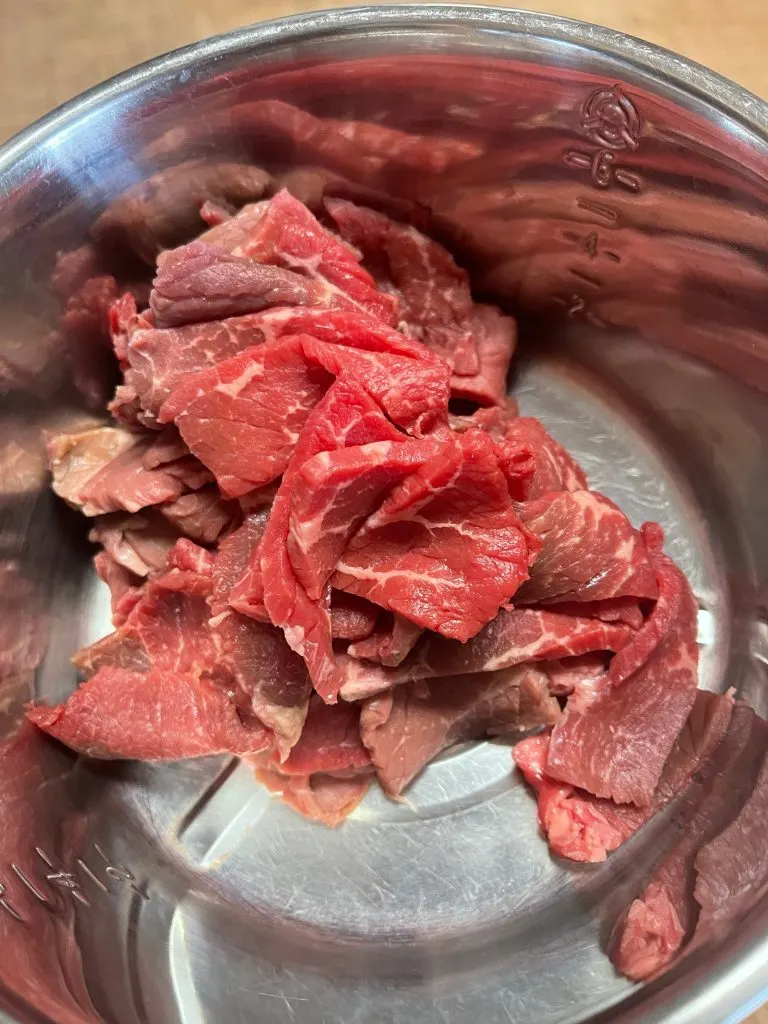
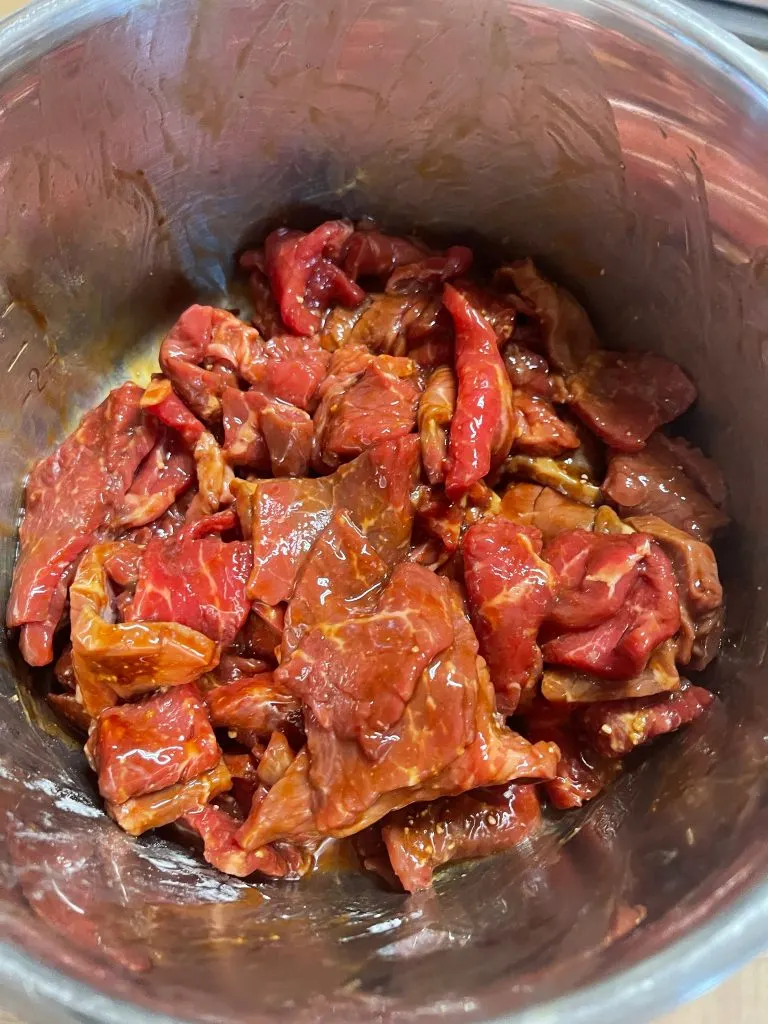
Heat cooking oil in a wok or cooking pan, and add the marinated beef along with the sauce in to pan and stir fry for about 2 minutes or until mostly browned, and then remove from heat.
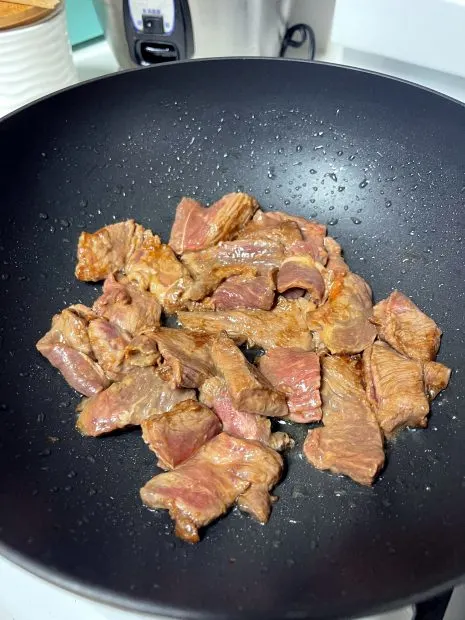
Add sliced onions, garlic, and dried red peppers in to pan to the pan, and stir fry for about 2 minutes or until the onions start turning translucent.

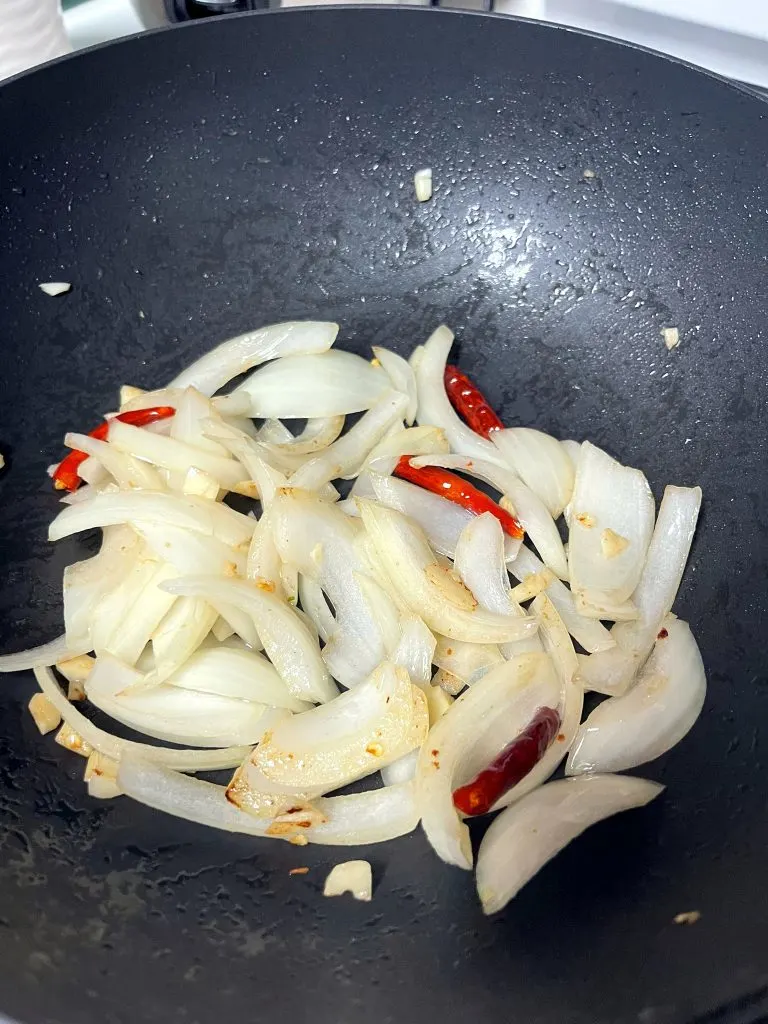
Add the beef back to pan and stir fry for about 1 more minute, then add the green onions, and stir fry until everything is cooked thoroughly.
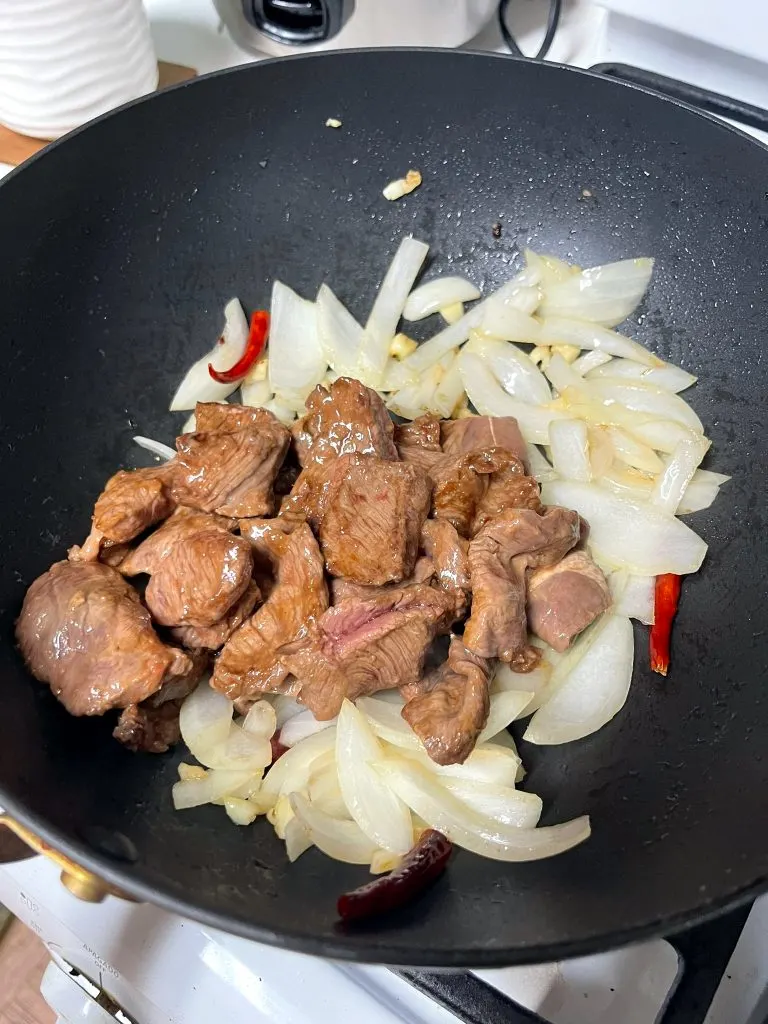
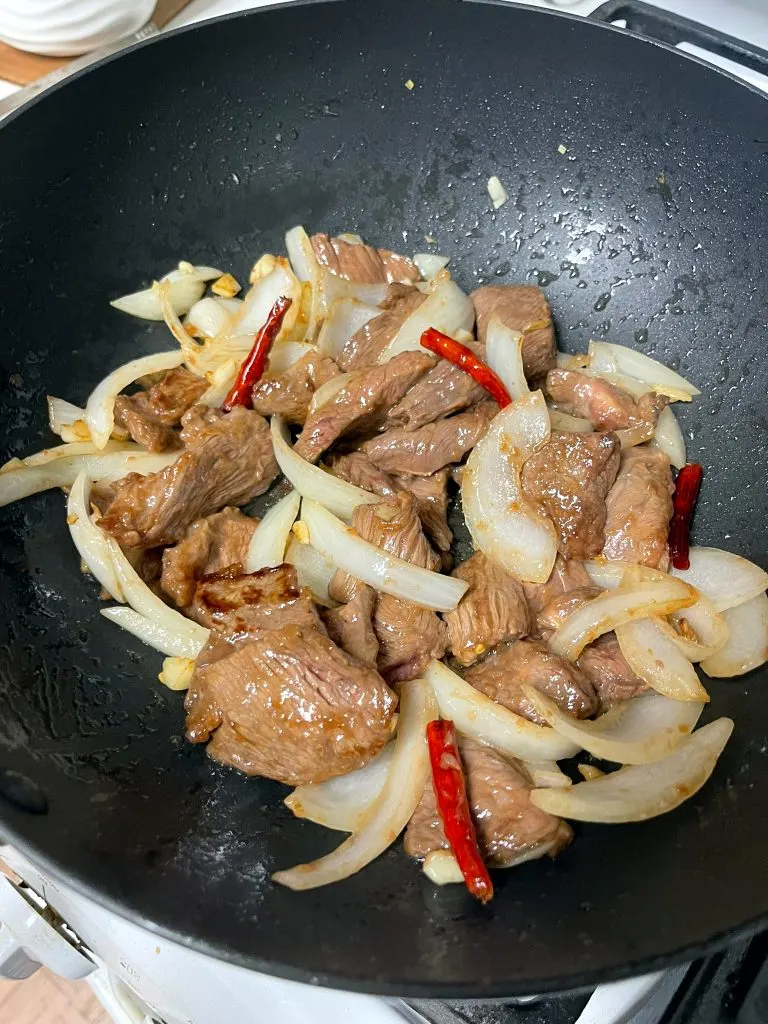
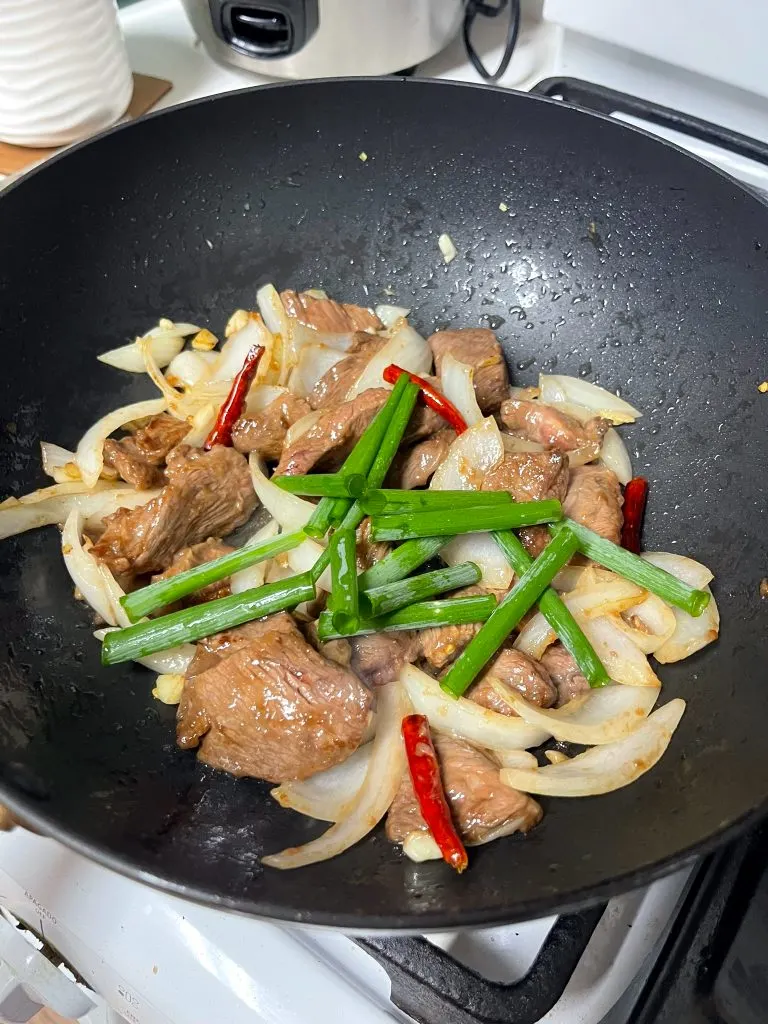
Add thick soy sauce and mix well, then remove from heat and serve!

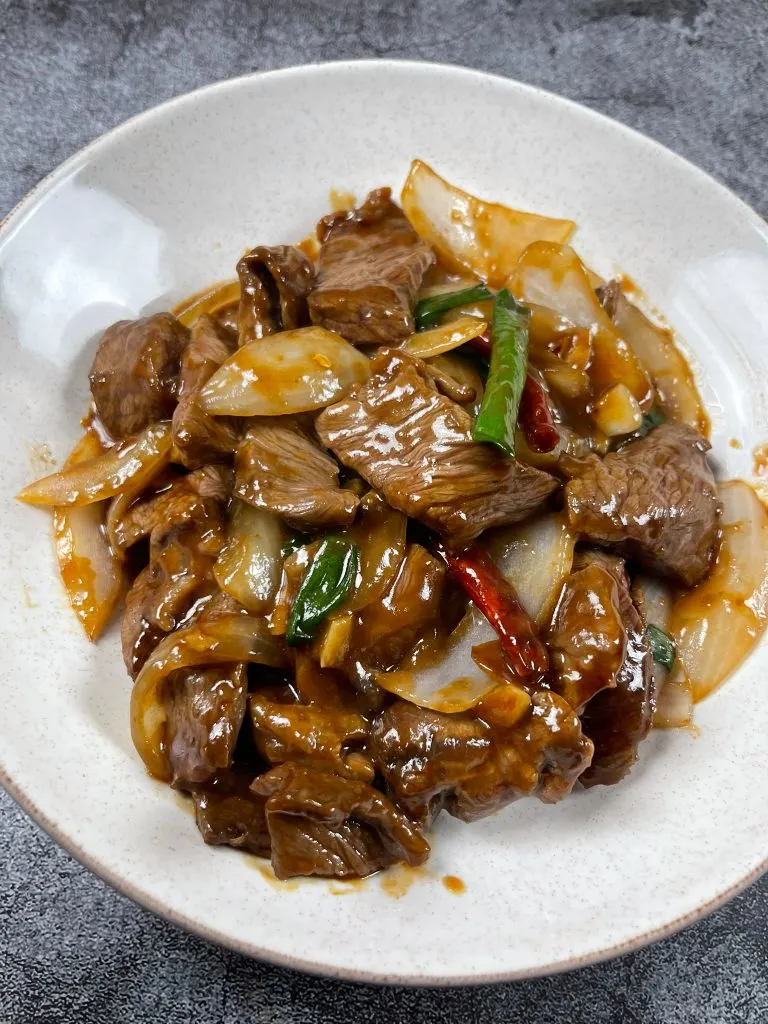
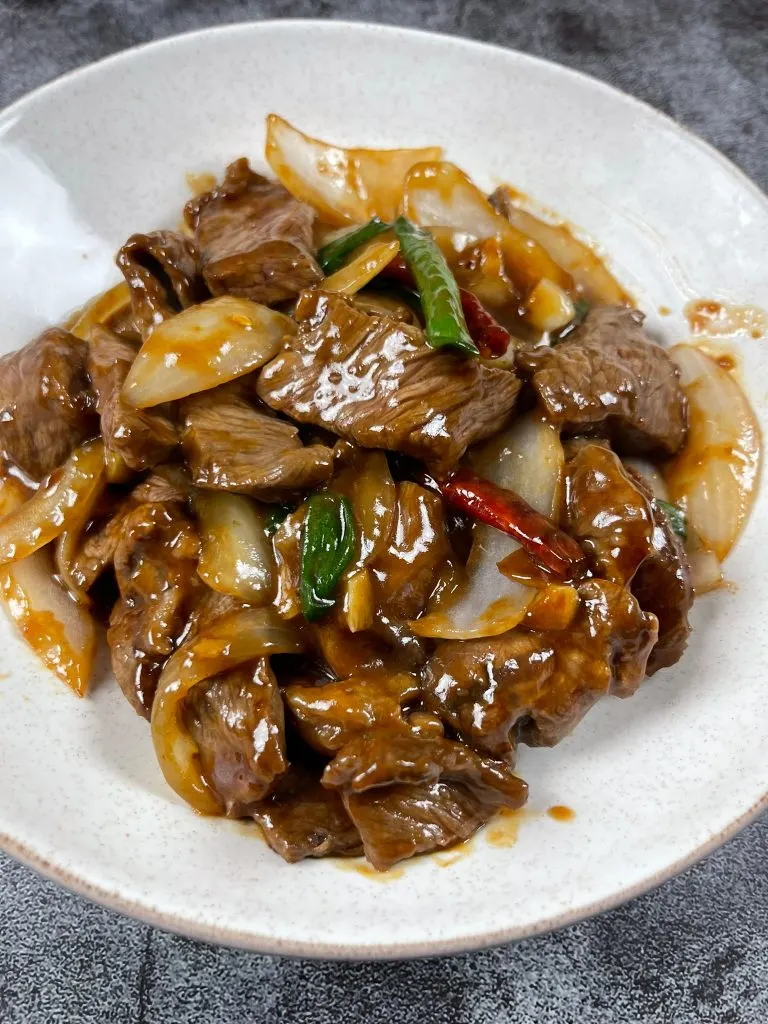
Here's the one time I made it with strips instead:
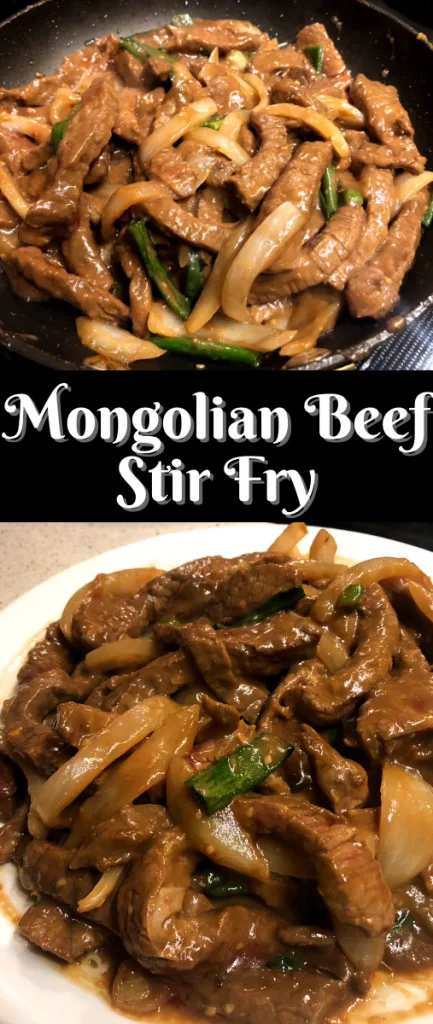
Mongolian Beef Stir Fry
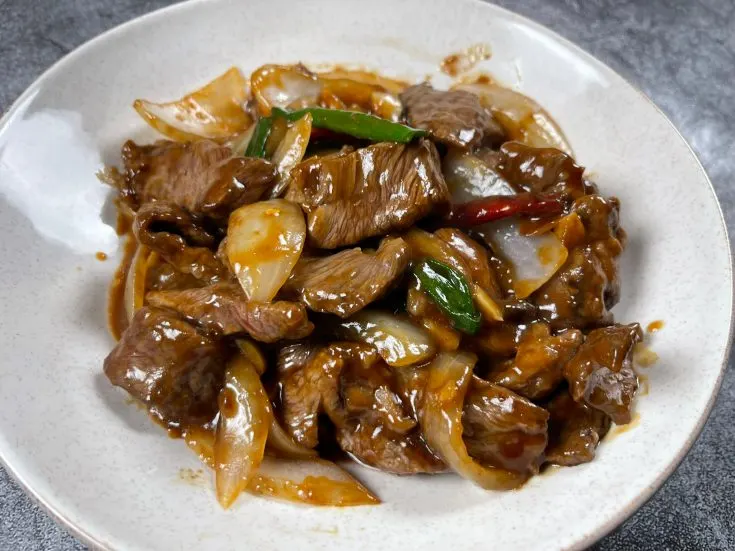
Mongolian Beef is a delicious beef stir fry recipe served with lots of onions and a tasty sauce. This flavorful dish is popular in Chinese restaurants, and also actually very easy to make at home – here’s my Mongolian Beef Stir Fry recipe!
Ingredients
Beef Marinade:
- 1 lb flank steak, cut in to strips or thinly sliced
- ½ cup soy sauce
- 2 tablespoon cornstarch
- 2 tablespoon honey or brown sugar
- ½ teaspoon ground ginger
Stir Fry
- 2 tablespoon cooking oil, separated
- ½ onion, sliced
- 4 cloves of garlic, minced or roughly chopped
- 2 stalks of green onions, cut in to 2 inch length
- 2 tablespoon soy paste (aka thick soy sauce)*
- Dried red peppers, optional
Instructions
- In a bowl, add beef with soy sauce, cornstarch, honey (or sugar) and ground ginger together. Combine well and set aside to marinade for 30 minutes or up to overnight in the refrigerator.
- Heat cooking oil in a wok or cooking pan, and add the marinated beef along with the sauce in to pan and stir fry for about 2 minutes or until mostly browned, and then remove from heat.
- Add sliced onions, garlic, and dried red peppers in to pan to the pan, and stir fry for about 2 minutes or until the onions start turning translucent.
- Add the beef back to pan and stir fry for about 1 more minute, then add the green onions, and stir fry until everything is cooked thoroughly.
- Add thick soy sauce and mix well, then remove from heat and serve!
Notes
*Thick Soy Sauce: In addition to regular light soy sauce, I also use Thick Soy Sauce, aka Soy Paste in this recipe. There’s actually many different types of soy sauce! Thick soy sauce is a lot thicker than your normal soy sauce. It has a richer, sweeter flavor, which is perfect for this dish.
If you can’t find any thick soy sauce, you can actually use regular soy sauce. However, since Thick soy sauce is more sweet, you are now missing a flavor, so I would recommend adding a bit of sugar or sweetener of your choice.
Or even more simple – Oyster sauce can often be used as a substitute because it is similar in texture and it is also salty and sweet at the same time.
By the way you can find these sauces, in your local Asian grocery store or even on amazon here:
Recommended Products
As an Amazon Associate and member of other affiliate programs, I earn from qualifying purchases.
-
 Kimlan Soy Paste, aka Thick Soy Sauce
Kimlan Soy Paste, aka Thick Soy Sauce -
 Hiware 10-Pairs Fiberglass Chopsticks - Reusable Chopsticks Dishwasher Safe, 9 ½ Inches - Black
Hiware 10-Pairs Fiberglass Chopsticks - Reusable Chopsticks Dishwasher Safe, 9 ½ Inches - Black -
 Cooks Standard Stainless Steel Stir Fry Pan with Dome Lid 13-Inch Multi-Ply Clad Wok, Silver
Cooks Standard Stainless Steel Stir Fry Pan with Dome Lid 13-Inch Multi-Ply Clad Wok, Silver -
 Lee Kum Kee Premium Light Soy Sauce, 16.9-Ounce + Lee Kum Kee Premium Dark Soy Sauce - 16.9 fl. Ounce + One NineChef Spoon
Lee Kum Kee Premium Light Soy Sauce, 16.9-Ounce + Lee Kum Kee Premium Dark Soy Sauce - 16.9 fl. Ounce + One NineChef Spoon -
 Nature Nate's 100% Pure Raw & Unfiltered Organic Honey; Product of Brazil and Uruguay; Packaged in 16 Ounce. Squeeze Bottle; Enjoy Honey's Balanced Flavor and Wholesome Benefits
Nature Nate's 100% Pure Raw & Unfiltered Organic Honey; Product of Brazil and Uruguay; Packaged in 16 Ounce. Squeeze Bottle; Enjoy Honey's Balanced Flavor and Wholesome Benefits
Nutrition Information:
Yield:
4Serving Size:
1Amount Per Serving: Calories: 370Total Fat: 17gSaturated Fat: 4gTrans Fat: 0gUnsaturated Fat: 11gCholesterol: 90mgSodium: 1824mgCarbohydrates: 20gFiber: 2gSugar: 12gProtein: 35g
The nutrition information for this recipe is an approximate total per serving. Please double check the nutrition information for your exact ingredients and brands for more precise nutrition information.
Pin for later!
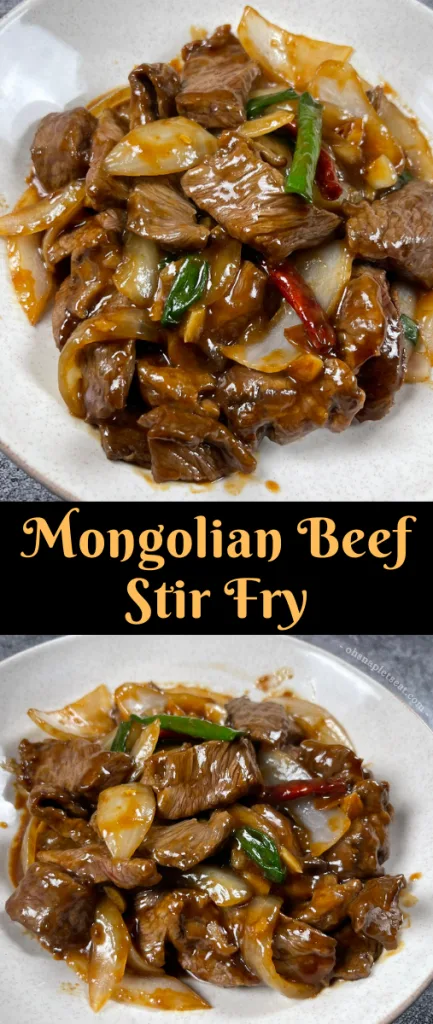

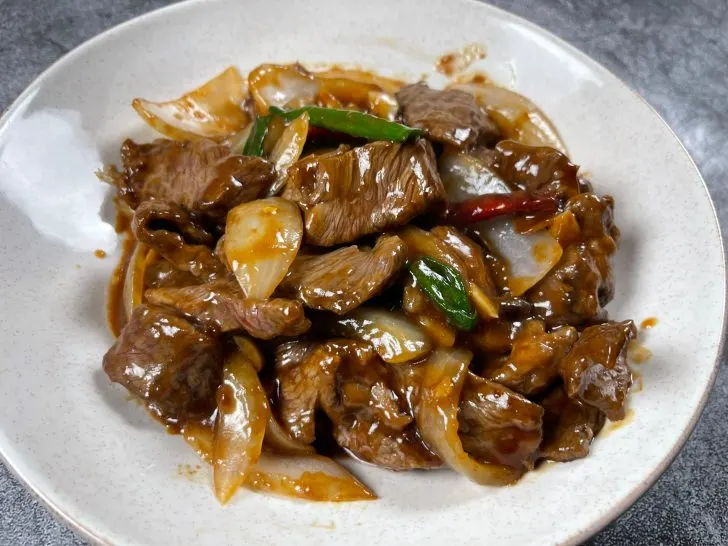
Nancy M
Wednesday 26th of June 2024
Hi - The instructions call for adding the minced garlic to both the beef marinade as well as with the slivered onions at stir-fry time. Should I divide the garlic called for in the marinade step and reserve half for adding with the onions?
Thanks!
TinaTsai
Thursday 27th of June 2024
Hi there! Sorry about the confusion, sometimes I marinade with it, sometimes I add it with the onions, and sometimes I do both! All of it works, but I actually meant to say add with onion tho, so I will update it to that. Thanks for catching that!!